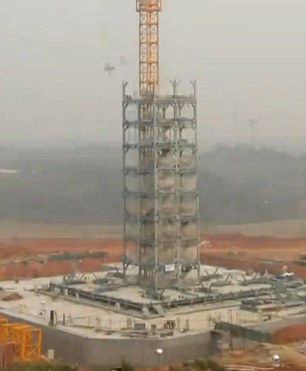China's sky is the limit
- By Li Xiaohua
 0 Comment(s)
0 Comment(s) Print
Print E-mail China.org.cn, June 28, 2012
E-mail China.org.cn, June 28, 2012
|
|
|
Over the next seven months, an 838-meter-high (0.52 mile) skyscraper will be constructed in Changsha. [File Photo] |
Over the next seven months, an 838-meter-high (0.52 mile) skyscraper will be constructed in Changsha according to an agreement Broad Group and the local government in southeastern China signed on June 5, China Business Journal reported. The structure will be 10 meter higher than the Burj Khalifa Tower which is currently still the tallest building in the world.
Eighty-seven percent of skyscraper construction worldwide now takes place in China, stated "Motian City", a Chinese website for skyscraper enthusiasts. The number of skyscrapers under construction in China now exceeds 200, which equals the total number of all skyscrapers currently standing tall across the U.S. Estimates show that over the coming three years, one skyscraper will be completed every five days.
Nowadays, most skyscrapers in China are located in first-tier cities. On the one hand, these cities have relatively limited land resources; yet on the other hand, these cities are highly commercialized and skyscrapers can actually advance the development of any neighboring areas, said Li Bin, an architect with the China Architecture Design & Research Group.
"A skyscraper could be Changsha's white elephant. It currently is just a second-tier city in Hunan Province," explained analyist He Tian from the China Index Academy.
The GreenLand Group, which focuses on skyscraper construction, has told media that it is the government who wants to put up these landmark skyscrapers, not the group itself. This does not, however, take away from the fact that real estate companies just cannot resist preferential land policies. "Not only can they acquire the land at a fairly low price, but they also benefit from many preferential policies," said Chen Baocun, director of the China Real Estate Chamber of Commerce.
Skyscrapers can boost the local economy and develop local tourism. This could be one explanation for the government's enthusiasm for skyscrapers. But beware! Research by foreign-funded institutions shows that over the past 140 years, a craze for skyscraper construction is a reliable signal for an impending economic crisis. The Chrysler Building and the Empire State Building were erected shortly before the Wall Street crash and the Great Depression hit the U.S. The latest examples of this theory would be those skyscraping office buildings and hotels in Dubai, including the Burj Khalifa Tower. Soon after these buildings were completed, economic crisis hit the country.
"The building boom starts with easy credit," said Andrew Lawrence, a Hong Kong-based analyst for Barclay's Capital, "But it also comes with a sense of blinding positive anticipation. By the time the building spree has ended, the local economies will already have taken a turn for the worse."
China's economic statistics of the past five months have also sent out a warning signal. From January to May, the growth rate of China's financial revenues decreased remarkably, especially when compared to last year's numbers. China's Purchasing Managers Index (PMI), a record of the country's manufacturing activity, in May displayed the end to five consecutive months of growth and declined to 50.4 percent. The PMI in May was down by 2.9 percentage points from that in April. China's Producer Price Index (PPI), a main gauge of inflation at the wholesale level, fell by 1.4 percent in May from a year earlier and marked another month of year-on-year decline after China's PPI had witnessed a drop in March for the first time since December 2009. All these elements indicate an economy on the slow-down.







Go to Forum >>0 Comment(s)